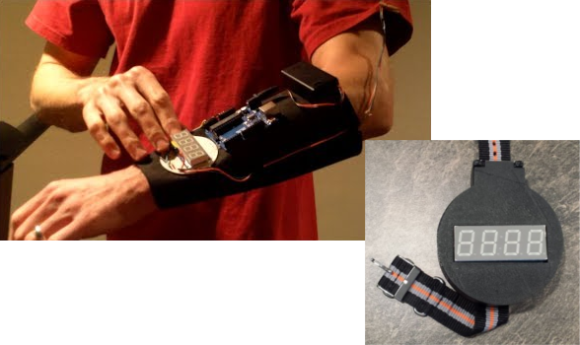
The tech involved in the fitness world really empowers athletes, whether they’re serious or not, to improve their performance by providing empirical evidence. The Striker project focuses on cadence, which is the frequency of strides when running, or revolutions when pedaling. It uses a force sensitive resistor in the shoe to measure footfalls or power strokes.
The concept behind the device is solid, and there are consumer-grade devices already on the market that are capable of performing the same functions. In fact, a Garmin device is used to help measure the accuracy of the system. But we love to see bootstrapped projects, and this one distinguishes itself not only in finished product, but in the process itself. To us it screams: “What are you waiting for, build a prototype and then iterate!”.
The larger image above shows the earliest working version which is just a piece of fabric that wraps around the forearm to hold a 4-digit 7-segment display. The wire following the arm of the wearer snakes all the way down to the shoe to connect with the force sensor. The image to the right is the first wireless version of the readout. But the project has already seen at least two more versions after this one, mostly using SparkFun components.
We think this is but one example of the kind of stuff we want to see as contenders for The Hackaday Prize. The project uses Open Design and it’s arguably a connected device because the sensor and readout connect to each other (but ideally you’d want to add more connectivy to get at the data). The open nature of the build could lead to leaps forward in the technology by affording talented people wider development access.














Given the LED display and hand mount, at first I honestly thought this device measures how fast you can… Um-yea, I am childish.
Might be hard but my thought was do you really need anything on your feet? Shouldn’t you be able to sense the feet striking ground with just an accelerometer and an mcu? Of course the data analyzing and filtering to detect strikes among other movements might be a harder problem to get good enough.
For running, sure, but an important distinguishing feature here is that it also measures cycling cadence. I’ve got a Fitbit which is essentially that, an accelerometer and a MCU, worn on the wrist. It can figure out walking and running alright, but it doesn’t register at all when cycling since the wrist is held relatively still.
This is something similiar to what I’m entering into the contest, except I’ll be sensing heart activity and linking to a phone:)
Why do people always use the whole Arduino board ? I can understand why you’d do that for a quick prototype on your desk, but once you decide to strap something to your body, wouldn’t it be nicer to just use the AVR ?
The Arduino comes with a +10 bonus to Blog Cred.